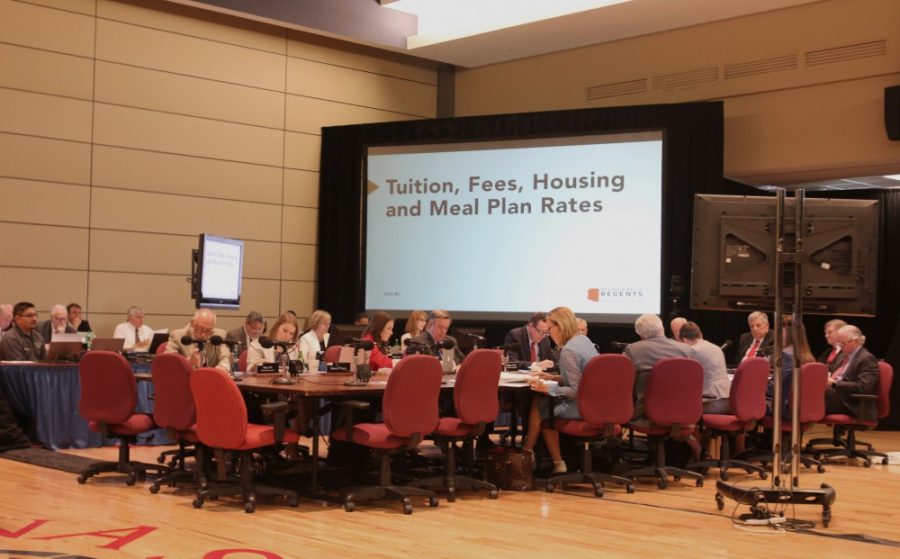The Arizona Board of Regents, the governing body for Arizona’s three public universities, discussed Arizona demographics and the University of Arizona’s Health Sciences’ strategic plan in its on-campus meeting in the Student Union Memorial Center North Grand Ballroom on Friday, April 12.
Arizona Demographics Presentation
Jim Chang, Arizona’s state demographer, presented demographic trends in Arizona and the United States.
Chang has been state demographer since 2012. He produced official population estimates and projections, which are then used by state agencies and local government for various purposes.
RELATED: Regents approve tuition increases, face student protesters on campus
Chang projected the Hispanic population in Arizona to increase to from 32.3 percent currently to 37.1 percent by 2035. He also indicated Arizona has a high rate of poverty compared to the United States, and Arizona has a lower rate of total population 25 and older that hold a bachelor’s degree compared to the rest of the United States.
In the 25-plus age group with bachelor’s degrees, over 30 percent were born in Arizona and reside in other states.
“We have to keep talent in Arizona to stay here and be educated,” said Rita Cheng, president of Northern Arizona University.
Overall, the fertility rate of the general population has been decreasing since 2006.
Chang also warned the population could potentially shrink in the future.
“If we don’t have migration, we will eventually turn into a shrinking population,” he said.
UA President Dr. Robert C. Robbins called the demographics a “very disturbing data set.”
“If you go back to the birth rate … my understanding is for a society to have a replacement population … I thought the birth rate needed to be 2.1 percent, and we’re below that,” Robbins said.
Michael Crow, president of Arizona State University, wanted to know how demographics can influence regent decisions.
“One way to do that is to make certain that we think about demographics,” Crow said. “What I’m really interested is the totality of learner demographics.”
UA Health Sciences Strategic Plan
The board discussed the UAHS strategic plan, which has five themes: “future-proof” graduates; health, well-being and quality care for all; aging for life; unlock human resilience and innovation powerhouse.
To “future-proof” graduates, UAHS wants to prepare health professionals for inevitable changes and new challenges. With health, well-being and quality care for all, the goal is to pursue health equity by increasing innovation in healthcare access, research and delivery. The goal with aging for life is to dramatically improve health and happiness in every stage in life. Unlocking human resilience involves adapting a body’s immune system to thrive in changing environments.
Dr. Michael Dake, UA’s senior vice president for Health Sciences, discussed some of the 26 initiatives under the five themes that UA wants to achieve.
Dake said one goal was to become a top 25 ranked university of Health Sciences. Another was to reduce the student debt by 20 percent by 2024.
Another initiative is to address substance abuse and addiction, specifically the opioid crisis, and reduce substance related deaths by 25 percent by the year 2024.
“I believe we can be competitors in these spaces,” Robbins said, referencing the goal to become premier Health Science innovation space.
Robbins thanked everyone for participating in the UAHS plan.
“The health science [plan] has really come together in a way that is really collaborative,” Robbins said.
RELATED: Regents approve development of two new majors, new college on campus
Regent Larry Penley said the plan is consistent with what ABOR has seen from UA’s strategic planning efforts.
“This is a bold plan with relatively short timeline for achievement and a distinctive focus for what can be delivered,” Penley said.
Closing Remarks
Robbins addressed yesterday’s protests and affirmed the campus’ commitment to free speech.
“I think there was a lot of very positive discussion, not the least of which was bringing to the forefront issues we have to give about culture and free speech,” Robbins said. “And these are issues that we will be taking on in the coming months.”
Mekayla Phan contributed to this article
Follow Priya Jandu on Twitter









